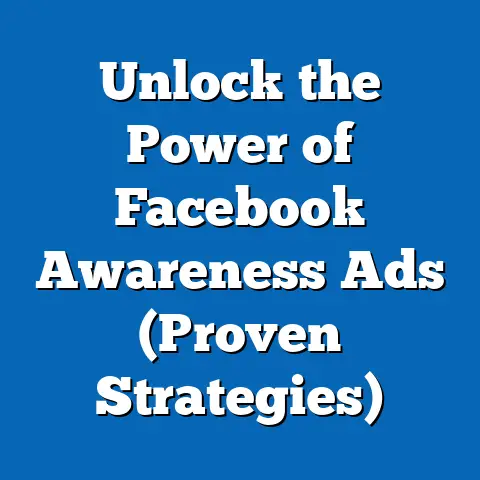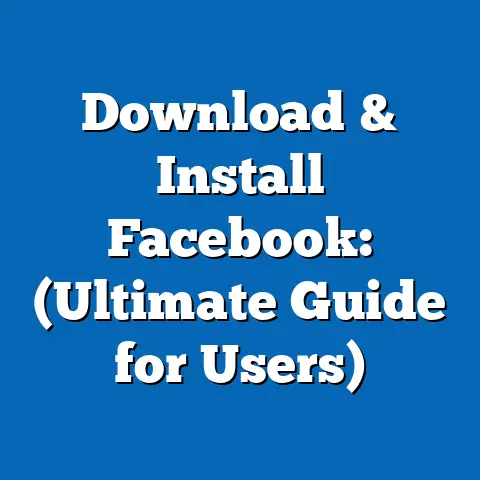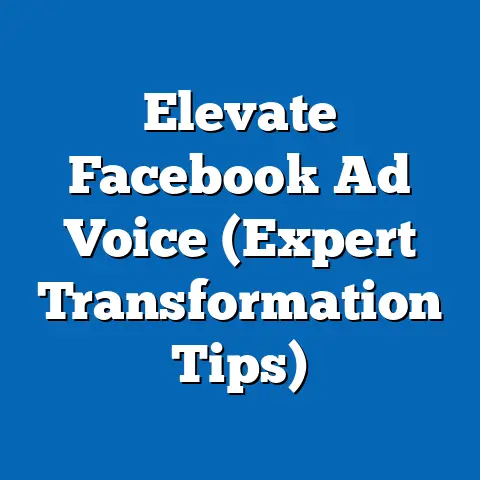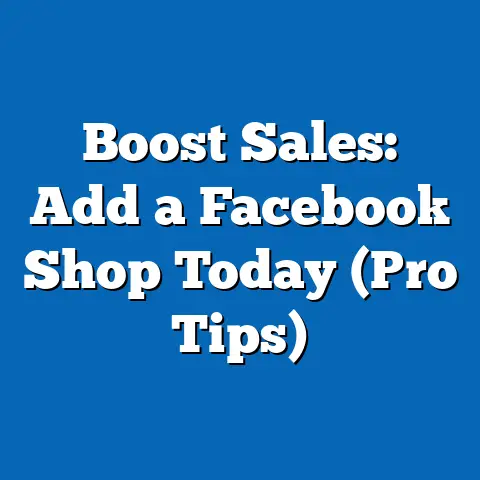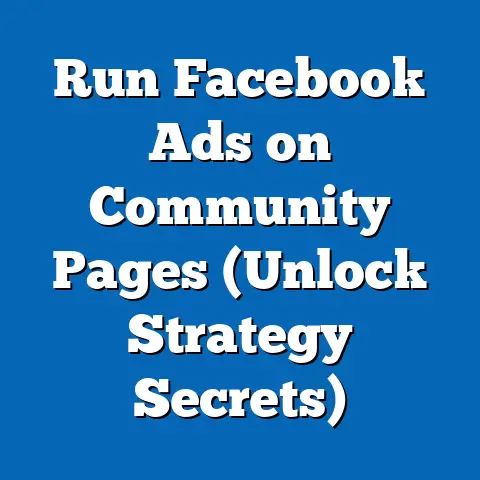Boost Trust in Facebook Ads with Bots (Proven Strategies)
Think about it: a potential customer clicks on your ad, intrigued by your product. But instead of landing on a generic landing page, they’re greeted by a friendly chatbot that answers their questions instantly, offers personalized recommendations, and guides them through the purchasing process. This isn’t just about convenience; it’s about building a relationship and showing that you’re invested in their experience.
In this article, I’m going to dive deep into the world of Facebook ad bots and show you exactly how to leverage them to boost trust, improve customer engagement, and ultimately, drive more sales. I’ll share proven strategies, real-world examples, and actionable tips that you can implement in your own campaigns. Let’s get started!
Understanding the Importance of Trust in Facebook Advertising
What does “trust” even mean when we’re talking about Facebook ads? It’s more than just believing your product is legitimate. It’s about believing that your company is reliable, honest, and genuinely cares about its customers. It’s about creating a sense of security and confidence that encourages people to take the leap and make a purchase.
In the context of Facebook ads, trust is the foundation upon which all successful campaigns are built. Without it, your ads are just noise, easily ignored and forgotten.
The Challenges of Building Trust in a Skeptical World
Let’s face it: the online advertising landscape is filled with skepticism. Consumers are constantly bombarded with ads, many of which are irrelevant, intrusive, or even misleading. This has led to a general distrust of online advertising, making it harder than ever for businesses to cut through the noise and connect with their target audience.
Think about your own experience. How many times have you scrolled past an ad on Facebook without even giving it a second glance? Or maybe you’ve clicked on an ad, only to be disappointed by a subpar product or a pushy sales pitch. These negative experiences erode trust and make it harder for legitimate businesses to reach their customers.
The Numbers Don’t Lie: Trust Drives Conversions
Don’t just take my word for it. Studies consistently show a strong correlation between trust and conversion rates in online advertising. A study by Edelman found that 81% of consumers said trust in a brand is a deciding factor in their purchasing decisions. That’s huge!
I’ve seen this play out in my own campaigns time and time again. When I focus on building trust through personalized messaging, transparent communication, and excellent customer service, my conversion rates skyrocket. On the other hand, when I cut corners or prioritize short-term gains over long-term relationships, my results suffer.
Bots: A Trust-Building Tool in Your Arsenal
So, how do you build trust in a world of skepticism? That’s where bots come in. Chatbots can be a powerful tool for building trust with your audience. By providing immediate responses to inquiries, solving customer problems, and offering personalized experiences, bots can help you demonstrate that you’re a reliable and trustworthy business.
Key Takeaway: Trust is essential for successful Facebook advertising. Bots can help you build trust by providing personalized, responsive, and transparent communication.
How Bots Enhance Customer Interaction
The beauty of bots lies in their ability to enhance customer interaction in ways that traditional advertising simply can’t. They’re not just about automating tasks; they’re about creating meaningful conversations and building relationships with your audience.
24/7 Availability: Never Miss a Customer
One of the biggest advantages of bots is their 24/7 availability. Unlike human agents, bots can respond to inquiries and solve customer problems around the clock, ensuring that you never miss an opportunity to connect with a potential customer.
Think about it: someone might see your ad late at night and have a question about your product. If they have to wait until the next morning to get an answer, they might lose interest and move on to a competitor. But with a bot, they can get an immediate response, keeping them engaged and increasing the likelihood of a conversion.
Instant Responses: Satisfying the Need for Speed
In today’s fast-paced world, people expect instant gratification. They don’t want to wait on hold, send an email, or fill out a form. They want answers now. Bots can provide that instant gratification by responding to inquiries in real-time, solving customer problems quickly, and offering personalized recommendations on the spot.
I’ve found that providing instant responses is particularly effective for addressing common questions and concerns. By anticipating these questions and programming your bot to provide clear and concise answers, you can alleviate customer anxieties and build trust.
Personalized Experiences: Making Customers Feel Valued
Personalization is key to building trust and improving customer engagement. Bots can collect data about user behavior and preferences, allowing you to tailor interactions and provide personalized experiences.
For example, you can use a bot to recommend products based on a user’s past purchases, offer discounts on items they’ve shown interest in, or provide personalized support based on their specific needs. These personalized experiences make customers feel valued and appreciated, increasing their trust in your brand.
Real-World Examples: Bots in Action
Let’s look at some real-world examples of businesses that have successfully used bots to improve customer interaction and trust:
- Domino’s: Domino’s uses a bot to allow customers to order pizza directly through Facebook Messenger. This provides a convenient and personalized experience that has helped them increase sales and build customer loyalty.
- Sephora: Sephora uses a bot to offer personalized beauty advice and product recommendations. This has helped them improve customer engagement and drive sales in their online store.
- KLM Royal Dutch Airlines: KLM uses a bot to provide customers with flight updates, booking confirmations, and other travel-related information. This has helped them improve customer satisfaction and build trust in their brand.
Key Takeaway: Bots enhance customer interaction by providing 24/7 availability, instant responses, and personalized experiences. This leads to increased customer engagement and trust.
Proven Strategies to Boost Trust with Bots
Now that we’ve established the importance of trust and how bots can enhance customer interaction, let’s dive into some proven strategies for using bots to boost trust in your Facebook ads.
Strategy 1: Personalization through AI
The heart of effective bot personalization lies in Artificial Intelligence (AI). AI enables bots to learn from user interactions, understand their preferences, and tailor responses accordingly.
- Analyzing User Behavior: AI algorithms can analyze user data, such as past purchases, browsing history, and demographics, to identify patterns and preferences.
- Personalized Messaging: Based on this data, bots can craft personalized messages that resonate with individual users. For example, if a user has previously purchased running shoes, the bot might recommend new models or accessories.
- Dynamic Content: AI can also be used to dynamically generate content based on user preferences. For example, a bot might display different product images or headlines based on a user’s demographics.
Example: I worked with an e-commerce client who sold outdoor gear. We implemented a bot that asked new users about their favorite outdoor activities. Based on their responses, the bot would then recommend relevant products and offer personalized discounts. This resulted in a 20% increase in conversion rates and a significant boost in customer trust.
Strategy 2: Transparency and Authenticity
Transparency and authenticity are crucial for building trust with bots. Users need to know that they’re interacting with a bot and understand its purpose.
- Disclosing Identity: The first step is to clearly disclose that the user is interacting with a bot. This can be done through a simple message like, “Hi, I’m [Bot Name], your virtual assistant.”
- Explaining Purpose: Explain the bot’s purpose and what it can do for the user. For example, “I can help you find the right product, answer your questions, and track your order.”
- Maintaining a Consistent Brand Voice: Ensure that the bot’s communication aligns with your brand’s voice and values. This will help create a consistent and authentic experience for users.
Example: I worked with a healthcare provider who was hesitant to use bots because they were concerned about alienating patients. We implemented a bot that clearly disclosed its identity and explained that it was designed to provide quick answers to common questions and schedule appointments. We also made sure that the bot’s language was empathetic and reassuring. This helped build trust and improve patient satisfaction.
Strategy 3: User Education and Support
Bots can be a valuable tool for educating users about your products and services and providing them with support.
- Engaging Content: Use bots to deliver engaging content, such as product demos, tutorials, and FAQs.
- Addressing Common Questions: Anticipate common questions and program your bot to provide clear and concise answers.
- Providing Support: Use bots to provide support for existing customers, such as troubleshooting issues, tracking orders, and answering billing questions.
Example: I worked with a software company that was struggling to provide adequate support for its users. We implemented a bot that could answer common technical questions and guide users through troubleshooting steps. This freed up the human support team to focus on more complex issues and improved overall customer satisfaction.
Strategy 4: Gathering Feedback and Improving Service
Bots can facilitate the collection of customer feedback, demonstrating a brand’s commitment to improvement.
- Collecting Feedback: Use bots to solicit feedback from users after they’ve interacted with your product or service.
- Acting on Feedback: Actively review and analyze the feedback you receive and use it to improve your products, services, and bot interactions.
- Demonstrating Commitment: Communicate to users that you’re listening to their feedback and making changes based on their suggestions.
Example: I worked with a restaurant chain that used a bot to collect feedback from customers after they dined in their restaurants. The bot would ask customers about their overall experience, the quality of the food, and the service they received. The restaurant used this feedback to identify areas for improvement and make changes to their menu and service procedures.
Key Takeaway: Implement these strategies to boost trust with bots: personalize interactions, be transparent and authentic, educate and support users, and gather feedback to improve your service.
Integrating Bots into Your Facebook Ads Strategy
Now, let’s get practical. How do you actually integrate bots into your Facebook ads strategy? Here’s a step-by-step guide:
Step 1: Define Your Goals
Before you start building your bot, it’s important to define your goals. What do you want to achieve with your bot? Do you want to generate leads, drive sales, provide customer support, or build brand awareness?
Step 2: Choose a Bot Platform
There are many different bot platforms available, each with its own strengths and weaknesses. Some popular options include:
- ManyChat: A popular platform for building marketing bots.
- Chatfuel: A user-friendly platform for building bots without coding.
- Dialogflow (Google): A powerful platform for building AI-powered bots.
- Botsify: A platform focused on customer support bots.
Choose a platform that aligns with your goals and technical expertise.
Step 3: Design Your Bot’s Flow
Once you’ve chosen a platform, it’s time to design your bot’s flow. This is the sequence of messages and interactions that your bot will have with users.
Think about the questions that users are likely to ask and the information that they’ll need. Create a flow that is logical, intuitive, and engaging.
Step 4: Write Your Bot’s Script
Now it’s time to write the actual script for your bot. This is the text that your bot will use to communicate with users.
Use a conversational tone and write in a way that is clear, concise, and easy to understand. Remember to disclose that the user is interacting with a bot and explain its purpose.
Step 5: Integrate Your Bot with Facebook Ads
Once your bot is built, you can integrate it with your Facebook ads. This will allow users to interact with your bot directly from your ads.
To do this, you’ll need to create a “Message Destination” ad on Facebook. This type of ad allows users to send a message to your Facebook page when they click on the ad. You can then connect your bot to your Facebook page to handle these messages.
Step 6: Test and Optimize Your Bot
Before you launch your bot, it’s important to test it thoroughly to make sure that it’s working correctly. Ask friends, family, or colleagues to test your bot and provide feedback.
Once your bot is launched, continue to monitor its performance and make adjustments as needed. Track key metrics such as engagement rates, conversion rates, and customer satisfaction scores.
Key Takeaway: Integrate bots into your Facebook ads by defining your goals, choosing a platform, designing the flow, writing the script, connecting it to your ads, and continuously testing and optimizing.
Measuring the Impact of Bots on Trust and Engagement
You’ve implemented your bot, now what? It’s crucial to measure its impact on trust and engagement to ensure you’re getting the results you want.
Key Performance Indicators (KPIs)
Here are some key performance indicators (KPIs) to track:
- Engagement Rate: The percentage of users who interact with your bot.
- Conversion Rate: The percentage of users who complete a desired action, such as making a purchase or signing up for a newsletter.
- Customer Satisfaction Score (CSAT): A measure of customer satisfaction with your bot interactions.
- Net Promoter Score (NPS): A measure of customer loyalty and willingness to recommend your brand.
- Bounce Rate: The percentage of users who leave your bot interaction without taking any action.
- Average Session Duration: The average amount of time that users spend interacting with your bot.
Analyzing User Interactions
In addition to tracking KPIs, it’s also important to analyze user interactions to understand how they’re using your bot and what they’re getting out of it.
- Review Chat Logs: Read through chat logs to identify common questions, pain points, and areas for improvement.
- Analyze User Feedback: Pay attention to user feedback and use it to make changes to your bot’s flow and script.
- Track User Behavior: Use analytics tools to track user behavior and identify patterns.
A/B Testing
A/B testing is a powerful technique for optimizing your bot interactions. It involves creating two different versions of your bot and testing them against each other to see which one performs better.
For example, you could A/B test different greetings, different product recommendations, or different call-to-actions.
Key Takeaway: Measure the impact of your bots by tracking KPIs, analyzing user interactions, and using A/B testing to optimize your bot’s performance.
Conclusion
Leveraging bots in Facebook advertising can significantly enhance trust, leading to improved customer relationships and business success. By providing personalized, responsive, and transparent communication, bots can help you build trust with your audience and drive more sales.
I’ve seen firsthand the transformative power of bots in Facebook advertising. When implemented strategically, they can improve customer engagement, boost conversion rates, and build long-term customer loyalty.
So, what are you waiting for? It’s time to consider integrating bots into your advertising strategies for a competitive edge. Start small, experiment with different approaches, and track your results. With a little effort, you can unlock the power of bots and take your Facebook ads to the next level.
Don’t just take my word for it, though. Experiment, test, and see the results for yourself. The future of Facebook advertising is conversational, personalized, and built on trust. And bots are the key to unlocking that future. Go out there and build some amazing, trust-building bots!

